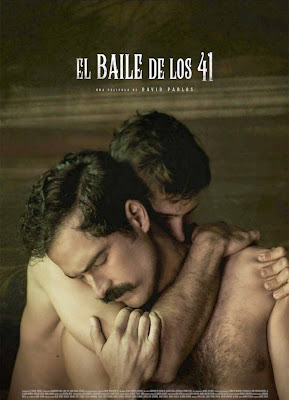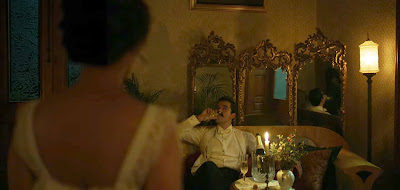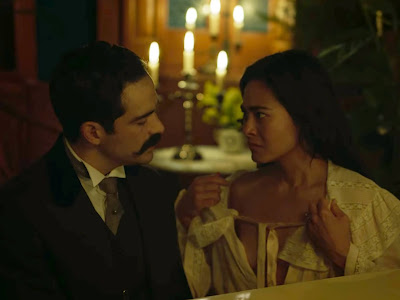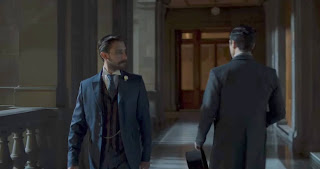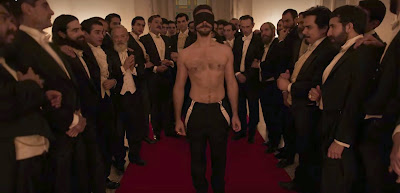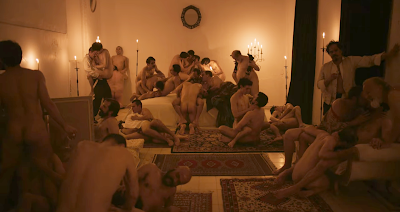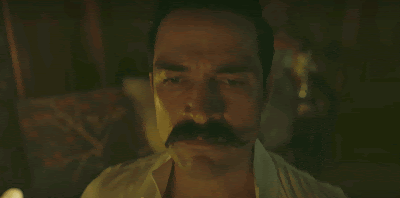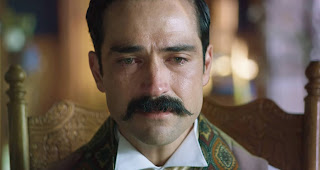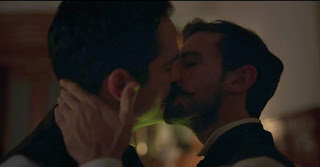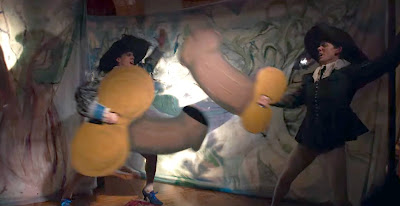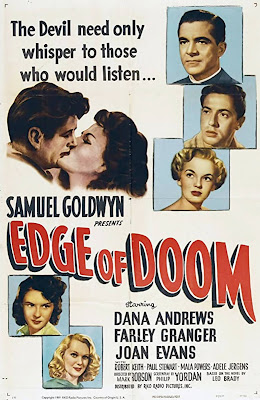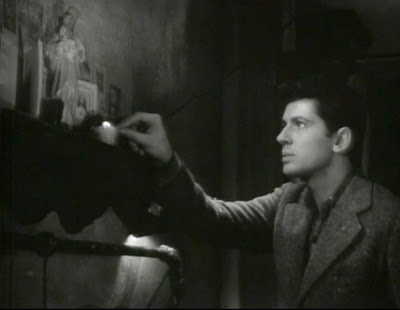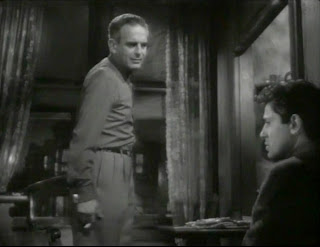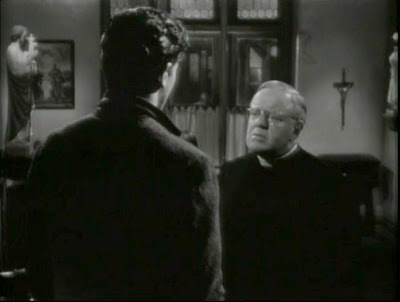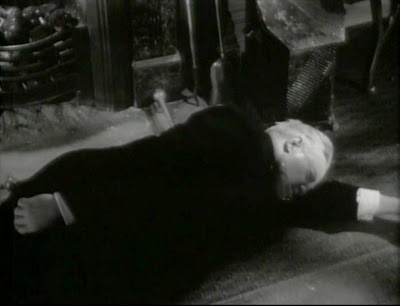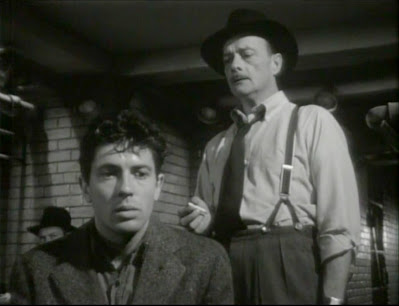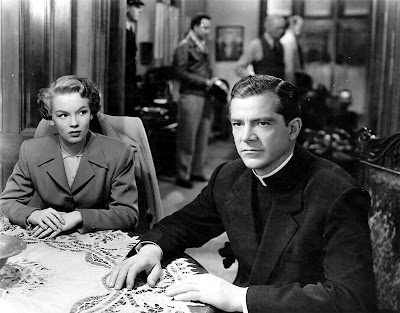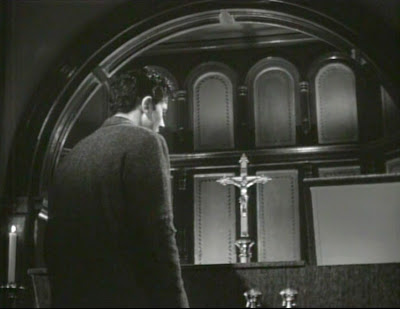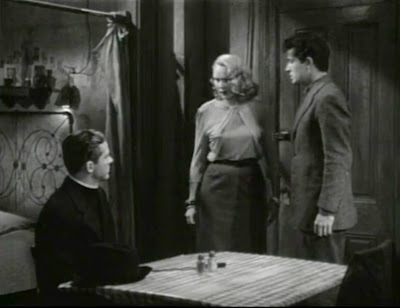Sharon Stone’s autobiography
The Beauty of Living Twice was published in March, so I thought in lieu of actually reading it I’d review some of her movies instead.
I, like a lot of people, became a fan of Sharon Stone after seeing Basic Instinct in 1992, for reasons that have nothing to do with the infamous interrogation scene (as established in previous posts, vaginas really aren’t of much interest to me). Basic Instinct was an over-the-top, trashy thriller and Stone’s performance as Catherine Trammel was spot-on.
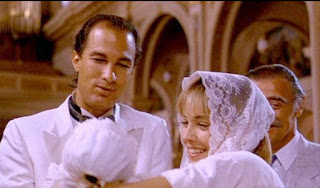 |
I don’t think showing her cooch on film is what
Sharon Stone should be embarrassed about.
|
Of course, this wasn’t the first time I’d seen Stone. She was in
Total Recall the previous year, and in the 1980s I saw her in
Action Jackson and the Steven Segal vehicle
Above the Law (I never said I was proud), but
Basic Instinct was the first time I
noticed her. And having noticed her I was happy for her to be my new favorite movie star. Lord knows Stone was eager to be one. It’s a safe bet that even as far back as when she was doing guest spots on
Remington Steele Stone spent her free time rehearsing her answers to reporters’ questions in the mirror, maybe even asking a girlfriend to hold a hairbrush up to her and pretend she’s Joan Rivers accosting Stone on the red carpet, just so she was ready when that fateful day finally came.
 |
*In Stone’s defense, this was her co-star.
|
As fascinated as I was by Stone as an actress, however, some of what I read about her gave me pause, including her claiming she was “tricked” into flashing her bearded clam in
Basic Instinct (um,
sure); her
assaulting a co-star*; and her
acting like a diva on set—even
before she became the face of the 1990s. I loved watching Sharon Stone the movie star, but I was finding it increasingly difficult to
like Sharon Stone the person.
Ultimately what cooled my Sharon Stone fandom was her movies. I didn’t want to see her as an Old West gunslinger or as Richard Gere’s cold wife. I wanted to see her in more deadly vixen roles. Her performance in Casino revived my faith, and I was further encouraged when she starred in the campy remake of Diabolique the following year. But then she became more interested in being taken seriously as an actress, meaning we got Oscar® bait like Last Dance, the sci-fi snoozefest Sphere, and the heartwarming The Mighty. I was kind of tempted to check her out in the 1999 remake of Gloria—it sounds like a hoot—but I never got around to it [update: finally did and it’s not as terrible as I expected]. Then, well, I kind of forgot about her… until Basic Instinct 2 came out. As awful/awesome as that was, it didn’t so much rekindle my Sharon Stone fandom as make me wish she’d just accepted she was the Joan Collins of the 1990s instead of exerting so much energy trying to convince us she was, if not the next Meryl Streep, then at least next Jessica Lange.
So, About Those Movie Reviews…?
I thought I’d check out a few films Stone made after health problems, ageism, bad behavior and bad choices forced her off her A-list pedestal, films like WHEN A MAN FALLS (a.k.a. When a Man Falls in the Forest), a movie I didn’t know existed until it popped up on Tubi and Prime. The Prime synopsis describes this 2007 movie as “a psychological thriller sure to keep you mesmerized right up to the shocking end.” None of that is true, and neither is the thumbnail poster, which gives Stone star billing.
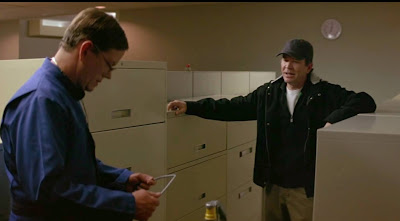 |
“Are you sure you don’t remember me? I won an Oscar®
for Ordinary People. What about Turk 182? No? Well, that’s fair.”
|
Writer-director Ryan Eslinger’s movie is actually a seriocomic indie drama about two men, Gary (Timothy Hutton) and Bill (Dylan Baker, looking like a live-action Matt Groening drawing), enduring bleak existences that they feel powerless to change. Gary is a genial alcoholic spinning his wheels in a dying marriage and an unfulfilling job; Bill, the night janitor at the building where Gary works, is so pathologically shy he flinches when people say hello to him. There’s a third, peripheral character, Gary’s friend Travis (Pruitt Taylor Vince), who’s life has been idling in grief mode since his wife was killed in a car wreck four years ago. Gary and Travis also went to high school with Bill, and it’s made clear that Bill was not their friend (“We picked on him all the time,” Travis recalls).
The movie mostly flits back and forth between the Gary and Bill storylines. Gary is married to Karen (a de-glamorized Stone). “Karen… yeah, she’s Karen,” Gary sighs when Travis asks about his wife. He knows Karen’s depressed but neither Gary nor she seem interested in addressing their issues head on. Instead, she mopes and shoplifts; he shrugs and opens a fresh bottle of wine.
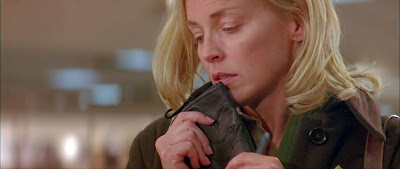 |
Sharon Stone is sure her contract allows her to keep these gloves.
|
Meanwhile, in a seemingly different movie, Bill struggles with what to do about Sadie (Stacie Bono), the young mother living in the neighboring apartment whom he regularly hears being smacked around by her partner. He knows he should do something, but he can barely bring himself to greet her when he encounters her in the hall, let alone save her. When Bill’s not cringing at the sounds of violence coming from next door, he’s dreaming, sequences that are even more discordant with the movie’s overall tone.
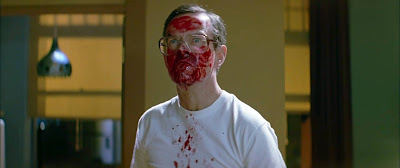 |
Dylan Baker dreams he’s in a more compelling film.
|
When a Man Falls is reminiscent of the little indie movies I rented from Blockbuster in the late 1980s – early ’90s that mixed understated drama and quirky comedy, brought to life by B-list talent. Except Eslinger not only fails to add all the necessary ingredients, he neglects to mix them properly. The drama never really goes anywhere, and the quirkiness sits on top like oil, never quite blending in with the rest of the movie. The Gary storyline is basically the equivalent of repeatedly asking your spouse what’s wrong and only getting a heavily sighed, “Nothing,” in response. Bill, on the other hand, seems to have wandered in from a different movie, albeit a more entertaining one. The only thing shocking about the ending, by the way, is how unfulfilling it is.
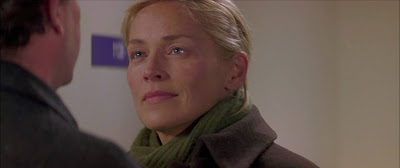 |
A face that says, “Fuck no, I’m not sorry.”
|
The acting makes
When a Man Falls semi-watchable, with every actor getting at least one effective scene or moment. Stone gets two: In one, after she’s been busted for shoplifting, she faces her husband not with a look of shame but a defiant see-what-you-made-me-do smile. In another, when asked to sign a card being passed around the office to celebrate t co-worker’s engagement, she refuses (I can’t count the number of times I’ve wanted to do this in real life). These scenes made me wish that there was more to her role and much more to
When a Man Falls.
Stone’s part in director Nigel Cole’s 2008 comedy $5 A DAY isn’t much bigger, but it’s a much better movie. Ritchie Flynn (Alessandro Nivola in a rare lead role), working as a health inspector until his boss learns of his prison past and fires him, is badgered by his estranged father Nat (Christopher Walken) to drive him from Atlantic City to Albuquerque, where Nat has signed up to participate in some experimental cancer treatment — or so Nat says. “You don’t have to dip into your pocket for a thing—zip, zilch, not even a crouton,” Nat assures his son.
Not that con artist Nat—who tips with gift cards for free phone minutes and helps himself to the free coffee offered to guests at a nearby casino—intends on dipping into his own pocket if he can help it. The car he’s secured for the trip is a PT Cruiser in a Sweet n’ Low wrap. (“Free wheels and gas for a year. All I have to do is drive a thousand miles a month!”), and he’s planned a route that includes an IHOP location every 300 miles, specifically so Nat can scam a free birthday meal using his many fake IDs.
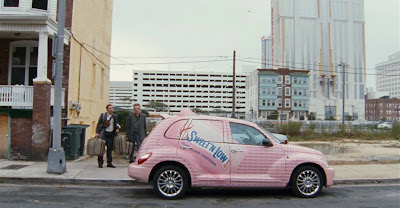 |
“Are you shitting me?” (Actual dialog)
|
So, yeah, it’s going to be a long drive for Ritchie, who resents his father after taking the fall for him so the old man, who already had priors, didn’t get slapped with a 10-year sentence. He also blames Nat’s bullshit for driving away his mother, who left Ritchie at a very young age. That Sweet n’ Low PT Cruiser isn’t helping matters, and neither is Nat’s insistence that they spend the night in a vacant house that’s up for sale. Nevertheless, when they’re surprised the next morning by a real estate agent showing the home to some potential buyers, Ritchie gamely plays along when Nat pretends they’re a couple. (“My partner and I are looking for something a little more feng
shew-ish.”)
In Springfield, Missouri, Nat sweet talks his way into a banquet for a convention of pharmaceutical salesmen, then pretends to be a rep himself—a ruse that almost works until Nat gets a little too chummy with a salesman’s wife. Ritchie arrives just in time to talk a group of angry drug salesmen out of beating the shit out of his father by flashing his I.D. and claiming Nat was on an undercover assignment for the health department. It’s a funny scene, just don’t think too hard about enjoying a performance by Fox News BFF Dean Cain.
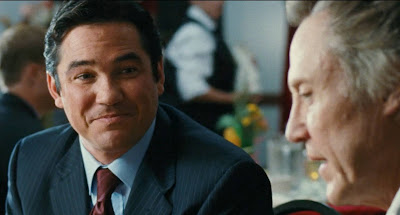 |
The fourth male lead of God’s Not Dead and the star of
The Deer Hunter, together at last!
|
While on the road Ritchie makes calls to his ex-girlfriend Maggie (Amanda Peet). She never picks up, but that doesn’t stop Ritchie from sharing stories about his life on her answering machine, since the main reason Maggie dumped him was he never shared anything about his past. Speaking of sharing, during a roadside piss stop, Nat tells his son he’s been impotent for several years, that not even Viagra can revive his wilted willie. Considering that if my father shared something similar I’d have to jab my car keys into my eardrums, Ritchie handles the news of his father’s E.D. with surprising nonchalance. Then again, he’s been to prison, so he probably has a higher threshold for what constitutes a breach of personal boundaries.
 |
| “You can’t get it up? Wish my cellmate had that problem.” | |
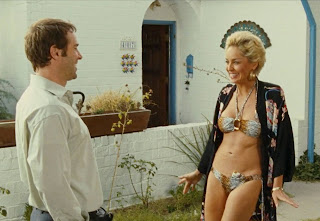 |
Ritchie caught in the path of a cougar.
|
Stone doesn’t appear until nearly an hour in, when the guys stop off in Amarillo, Texas, to visit Ritchie’s old babysitter, Dolores. An aging beauty with a spray-on tan and taste for sexy/tacky fashions (she greets them wearing a tiger print bikini and floral print kimono), Dolores is basically a parody of Stone’s
Casino character, Ginger. Nat, knowing that Ritchie once had a crush on her, sees the visit as an opportunity for Ritchie’s fantasy to come true, and maybe help get his son’s mind off his breakup with Maggie. Dolores happily agrees to go out for drinks with Ritchie, but while she’s flirtatious it’s clear Nat is whom she pines for. She would’ve hooked up with Nat, she tells Ritchie, but “I’ve never met a man who’s so in love with his wife.” Nat didn’t drive Ritchie’s mother away, Dolores reveals; she left Nat for a car salesman she’d been having an affair with.
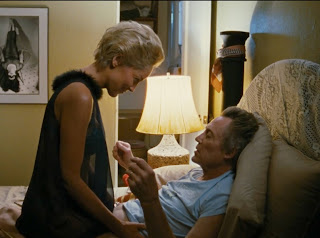 |
Dolores cures Nat’s impotence while
this scene causes ours.
|
Dolores’ word is called into question when it’s revealed she’s also a bit of scam artist, spilling a cup of coffee on herself and loudly claiming it was the waiter’s fault. The ploy should net her at least five grand, she later tells Ritchie. “I got my Mercedes with a trip in a supermarket last year.” Perhaps discovering Dolores is as duplicitous as his father is why Ritchie isn’t too broken up when his former babysitter bypasses inviting him into her bed and instead joins Nat in his (impotence cured!) And maybe Dolores is right, that Nat deserves a little love and affection, after all.
But Ritchie isn’t quite ready to forgive his father just yet, especially when he learns that Albuquerque is home to Kruger (Peter Coyote), the man Ritchie’s mother left Nat for.
$5 a Day is the sort of movie that’s described as cute rather than funny. Yet, while its laughs are mild, it’s still an enjoyable film and worth checking out (it going straight-to-DVD likely had more to do with its marketability than its quality). Even when Walken is bad he’s fascinating to watch, but he’s very good here, clearly enjoying in his outsized role. Likewise, Stone appears to be having a blast spoofing her sexy image as Dolores. Playing the movie’s straight man, Nivola manages to hold his own, never being overshadowed by his larger-than-life co-stars (he’s also pretty easy on the eyes).
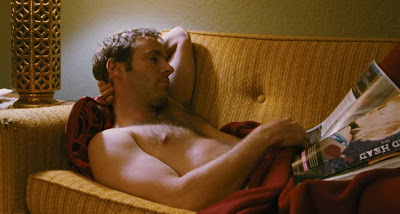 |
Though this couldn't hold a candle to a 60+ Christopher
Walken, apparently.
|
It Gets Worse… and So Much Better
In 2012, Stone finally got to sink her teeth into a Bonafide starring role. She also got to bring audiences bigger laughs than $5 a Day delivered. Behold, the drama BORDER RUN (a.k.a. The Mule).
It’s bad, y’all. But it’s the fun kind of bad, and that’s owed largely to Sharon Stone.
Though I consider Stone more of a movie star than an actress, she can act. However, I think the quality of her performances are often contingent on the strength of her directors. Judging by Border Run, I’m not even sure director Gabriela Tagliavini was ever on set. Or maybe when Tagliavini saw Stone emerge from hair and makeup looking like she was just a black leather trench coat away from playing a vampire matriarch in the Underworld franchise, she was simply too stunned to question her lead actor’s—and executive producer’s — choices.

And, boy, does Stone make some choices in Border Run. She plays Sofie Talbert, a conservative journalist working for a Fox News-esque station in Arizona (“fair and balanced” is even worked into the banter between Sofie and her producer). In one of the movie’s early scenes, we see Sofie elbow her way through a crowd of other reporters to get to a Republican senator — who nevertheless looks like a Hillary Clinton/ Dianne Feinstein composite perfect for Newsmax anchors to hate ’bate to — and ask couple gotcha questions about her past votes revealing a softness on border security. Getting the senator’s stammering non-answer on tape, Sofie gives us a satisfied smirk then scurries back to the station. The only thing that would make this scene better is if the senator, or one of the other reporters Sofie elbowed out of the way, was heard muttering, “Fucking cunt.”
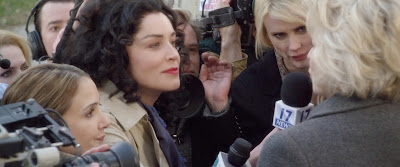 |
Stone nails the Megyn Kelly smirk.
|
Sofie’s career suddenly takes a backseat when she calls her brother, Aaron (Billy Zane), supposedly an SJW working in Mexico helping immigrants cross illegally into the U.S. And wouldn’t you know the moment he answers Sofie’s call he’s being shot at by
Minute Men. The immigrants get away, but Aaron isn’t so lucky, getting captured by some mysterious figures who may or may not be Americans. All Sofie hears is gunfire before the line goes dead. Understandably, she’s concerned. Sofie immediately heads to Nogales, Mexico, to search for him.
Getting nowhere with the local police, Sofie heads to the border relief agency where Aaron works. After checking out the office’s bulletin board, which features several of Sofie’s news clippings, Sofie talks with Aaron’s co-worker, Roberto (Manolo Cardona). Over empty coffee mugs Roberto tries to dissuade Sofie from looking for Aaron, but when it’s clear that she’s going to anyway he agrees to take her to Aaron’s last known whereabouts, a small shack within shooting distance of the U.S. border. They find a cigar butt with a distinctive gold band and, hanging on the border fence, Aaron’s cap. Their investigation is interrupted by gunfire, however (the Minute Men don’t like Sharon’s hair, either) forcing the pair to retreat.
Sofie calls a number she plucked from the relief agency’s bulletin board, reaching Javier (Miguel Rodarte), a coyote. Javier won’t answer any of Sofie’s questions over the phone and tells her to meet him in Altar. Roberto warns Sofie against going there because Altar is super dangerous. (Like they’re safe where they’re at? Hello! You all were just dodging bullets.) After Sofie says she’s going to Altar, with or without him, Roberto agrees to take her there.
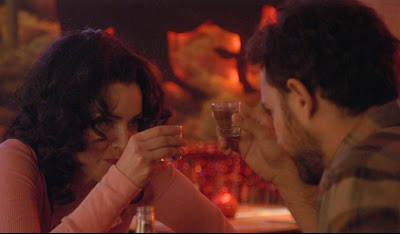 |
It stands to reason that if you need to drink to watch Border
Run, you need to get fucking hammered to star in it. |
|
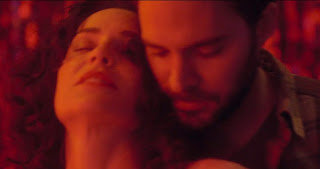 |
Border Run teases a gratuitous sex scene that
never happens. |
|
But first, dinner and drinks! So far, Stone has portrayed Sofie as a no-nonsense, headstrong woman solely focused on her objectives, be they humiliating RINOs on tape or finding her missing brother. The moment she and Roberto stop at a cantina and she gets a few drinks in her, Sofie becomes a silly, head-rolling drunk. And possibly an easy lay. When she and Roberto take a few turns on the dance floor, they begin to make out, hot n’ heavy. Fuck Aaron, Sofie’s gonna
get some!Alas, Roberto gets cockblocked by a purse snatcher, the theft sobering up Sofie instantly. Now she’s all business and all about meeting up with Javier. Of course, Sofie and Roberto get separated in Altar, and in his absence Sofie almost gets raped in an alley, only to be saved by…Javier. Well, that was convenient.
Sofie joins one of Javier’s coyote missions, which will supposedly lead her to Aaron. Standing directly in her path, however, is Juanita (Giovanna Zacarías, fucking owning her role), the vicious head of a crime ring trafficking in humans and cocaine. Upon discovering “a shitty gringa” amongst her smuggled migrants, Juanita reacts as any vicious crime boss would, but Javier talks her out of killing Sofie. After all, Sofie has so many more hilarious facial expressions to share.
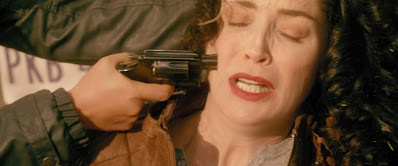 |
In Mexico, Sofie is just another “shitty gringa.”
|
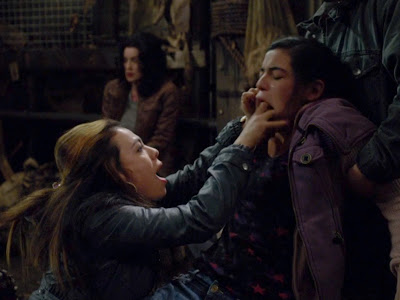 |
| Juanita inspects the more valuable merchandise. |
|
|
|
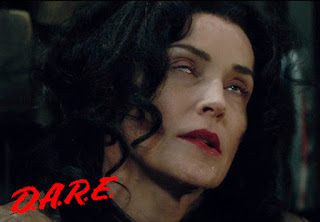 |
Stone stoned.
|
Aaron is being held captive by Juanita’s gang, and he sees his sister being smacked around by Juanita from a window in the room where he’s chained up. Were this a different kind of movie (i.e., the good kind), the story might have had Aaron formulating a plan with Sofie to escape, using Javier — who seems to be allowed unsupervised access to Juanita’s prisoner — as a go-between. But that’s some action movie shit, and
Border Run is still trying to be a gritty drama. So, Aaron remains chained up and powerless. Meanwhile, Sofie, just as powerless, watches as one of the smuggled migrants, a teen-aged girl, is roughly felt up by Juanita. We in the audience are powerless as we laugh hysterically watching Sofie succumb to the effects of some drugged water, with Stone giving a performance worthy of a 1968 classroom scare film about the dangers of marijuana. Within seconds of being drugged, Sofie rolls her eyes back into her skull and lolls her head from side to side, before quickly losing consciousness. Moments later, she comes to just long enough to realize she’s being tied to a bed, spread eagle, before blacking out again. She regains consciousness right before she’s raped. I think we can all agree that rape is a horrible crime, and therefore this scene should be horrific. Instead, Stone makes this the funniest scene of sexual assault since Pia Zadora was violated with a garden hose in
The Lonely Lady.
 |
Funniest rape scene or darkest episode of
The Muppet Show ever?
|
With Javier’s help Sofie manages to escape, but she and Javier are barely able to keep one step ahead from Juanita and her goons. Though they avoid capture by Juanita, they aren’t so lucky when they encounter U.S. Border Patrol. Javier is shot, and Sofie is taken into custody. Having met some real migrants and experienced firsthand the hell they endure to cross into the U.S. has caused Sofie to re-examine her hardline stance on border enforcement. Hence, she throws a hissy fit when being questioned by a Homeland Security officer (“I’m a TV reporter. I know my rights!”) When it’s suggested that if she doesn’t like America’s immigration laws she should contact her senator, Sofie angrily signs a release form, throws it at the officer and storms out.
 |
Oscar® nominee Sharon Stone.
|
But Sofie’s saga isn’t over yet. She still has to find Aaron. Fortunately, Roberto reappears to help her. Sofie’s relieved, until she sees him smoking a cigar with a distinctive gold band.
 |
Sadly, Sharon’s hair gets no redemption arc.
|
You can tell Border Run wants to be an important message drama about illegal immigration like El Norte, but it instead plays more like someone took a script for a 2000s-era Jean-Claude Van Damme direct-to-DVD actioner, changed the lead character’s gender and motivation, then replaced all the scenes of ass kicking with scenery chewing. It doesn’t work, but goddamn if it isn’t it fun to watch! The movie does have a kernel of a good idea, though: I’d so want to watch a reality show in which Fox News pundits are dropped in the middle of Honduras without their phones and are then tasked with having to make it back to the U.S. in one week with only a hundred Lempira, a few bottles of water, a couple Power Bars and a knife. The winner gets to suck Trump’s cock literally instead of metaphorically. Good luck, Sean!
Stone’s career has had something of a course correction in recent years. She got well-deserved positive notices for her performances in 2013’s Lovelace and the 2018 HBO series Mosaic, and she was perfectly cast as the eccentric heiress Lenore Osgood in Ryan Murphy’s American Horror Story retread Netflix series Ratched. If IMDb is to be believed, one of her upcoming projects is the comedy, The Tale of the Allergist’s Wife co-starring Bette Midler, which I’m sure will have a very professional and drama-free production should it ever happen [update: nope]. In the meantime, we have 30th anniversary edition of Basic Instinct to look forward to, which Stone says will be XXX-rated (😲).
Oh, Sharon. I love you, but you’re so full of shit.
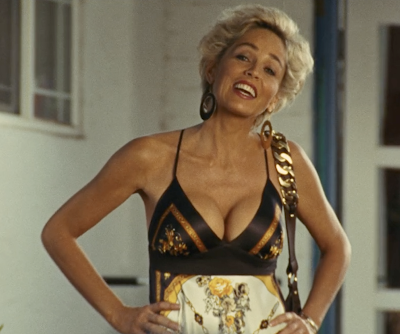 |
Her milkshake still brings the boys to the yard.
|




